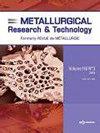基于卷积神经网络的KR脱硫过程石灰利用率预测模型
IF 0.9
4区 材料科学
Q3 METALLURGY & METALLURGICAL ENGINEERING
引用次数: 1
摘要
采用数据驱动技术,将脱硫工艺参数与石灰利用率进行关联,并应用卷积神经网络对Kambara反应器(KR)脱硫过程中的石灰利用率进行预测。结果表明,与支持向量回归模型和随机森林模型相比,卷积神经网络模型的相关系数值为0.9964,平均绝对相对误差为0.01229,均方根误差为0.3392。通过敏感性分析考察了工艺参数对石灰利用率的影响,结果表明,石灰质量和初始硫含量对石灰利用率有显著影响。通过分析在现有脱硫工艺参数下石灰重对石灰利用率的影响,得出石灰重从3256 kg降低到2332 kg可使石灰利用率提高5%左右的结论。本文章由计算机程序翻译,如有差异,请以英文原文为准。
A convolutional neural network-based model for predicting lime utilization ratio in the KR desulfurization process
In the presented work, desulfurization process parameters and the lime utilization ratio were correlated by data-driven technique, and a convolutional neural network was applied to predict the lime utilization ratio in the Kambara Reactor (KR) desulfurization process. The results show that compared with the support vector regression model and random forest model, the convolutional neural network model achieves the best performance with correlation coefficient value of 0.9964, mean absolute relative error of 0.01229 and root mean squared error of 0.3392%. The sensitivity analysis was carried out to investigate the influence of process parameters on the lime utilization ratio, which shows that the lime weight and the initial sulfur content have the significant effect on the lime utilization ratio. By analyzing the influence of the lime weight on the lime utilization ratio under the current desulfurization process parameters, it can be concluded that decreasing the lime weight from 3256 kg to 2332 kg can increase the lime utilization ratio by about 5%.
求助全文
通过发布文献求助,成功后即可免费获取论文全文。
去求助
来源期刊

Metallurgical Research & Technology
METALLURGY & METALLURGICAL ENGINEERING-
CiteScore
1.70
自引率
9.10%
发文量
65
审稿时长
4.4 months
期刊介绍:
Metallurgical Research and Technology (MRT) is a peer-reviewed bi-monthly journal publishing original high-quality research papers in areas ranging from process metallurgy to metal product properties and applications of ferrous and non-ferrous metals and alloys, including light-metals. It covers also the materials involved in the metal processing as ores, refractories and slags.
The journal is listed in the citation index Web of Science and has an Impact Factor.
It is highly concerned by the technological innovation as a support of the metallurgical industry at a time when it has to tackle severe challenges like energy, raw materials, sustainability, environment... Strengthening and enhancing the dialogue between science and industry is at the heart of the scope of MRT. This is why it welcomes manuscripts focusing on industrial practice, as well as basic metallurgical knowledge or review articles.
 求助内容:
求助内容: 应助结果提醒方式:
应助结果提醒方式:


